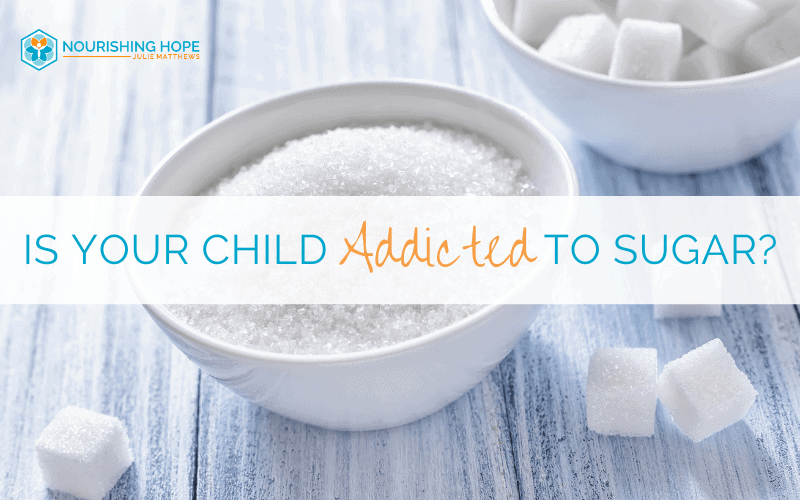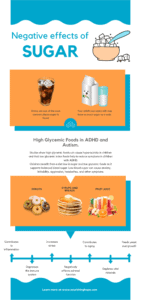
Most nutritionists recommend avoiding sugar in the diet—and applying this basic advice to kids is important.
Sugar is addicting and bad for our health.
But with all of the parent-child battles that can happen (screen-time, bedtime, chores, etc.) there can be so many disagreements and challenges between parents and children at times… is this a battle worth fighting?
Yes. It is. I’ll share why and how you can reduce the sugar in your child’s life without the tears.

Dangers Associated with Sugar
Not only is excessive sugar a problem in conditions such as diabetes, heart disease, and obesity. Sugar depresses many of the systems needed for good health, learning, and behavior.
Sugar consumption depletes vital minerals, such as: chromium, zinc, magnesium, and calcium.
Sugar increases cholesterol and triglyceride levels, and contributes to aging. Sugar also increases stress and negatively affects adrenal function.
Sugar depresses the immune system and contributes to inflammation. Supporting the immune system is crucial for everyone. And inflammation is common in: ADHD, autism, anxiety, depression, and virtually all health conditions.
Sugar also feeds Candida, a type of yeast that causes yeast infections and thrush, and imbalances the beneficial bacteria in the gut. Candida can cause digestive symptoms, as well as neurological symptoms in children and adults.
Sugar affects the immune and digestive system. This combination can be particularly problematic… 1) Sugar depresses the immune system that is important for fighting Candida, and 2) feeds Candida as well. Both of these factors then 3) contribute to further inflammation in the gut. For children with autism – and all children – this can be a real problem.

High Glycemic Foods in ADHD and Autism
High glycemic foods are those that are known to raise blood sugar rapidly. They include foods such as: fructose, high fructose corn syrup, bread, donuts, fruit juice, potatoes, and instant oatmeal.
Studies show high glycemic foods can cause hyperactivity in children and that low glycemic index foods help to reduce symptoms in children with ADHD. [1]
Researchers also found that glycemic index modulates the behavioral and biochemical abnormalities associated with autism including, that “diet modulates plasma metabolites, neuroinflammation and brain markers of neurogenesis in a manner that is highly reflective of ASD.” [2]
Children benefit from a diet low in sugar and low glycemic foods as it supports balanced blood sugar. Low blood sugar can cause anxiety, irritability, aggression, headaches, and other symptoms. And years of imbalanced blood sugar puts children at risk of type 2 diabetes.
Where Sugar is Found
Drinks are one of the most common places sugar is found. You might be surprised to find that your child’s non-dairy milk may have as much sugar as a soda!
Sugar in such lurking in unlikely places too. And 1 tablespoon of ketchup has a teaspoon of sugar that means it’s 1/3 sugar.
When sugar is concentrated, such as in fruit juice, you are getting a lot more sugar than you’d get from eating fruit (about 4 pieces of fruit in one bottle) with no fiber to balance it out.

Being aware of the sources of sugar will help you choose wisely. Here are some surprising sources and amounts of sugar:
- 1 tablespoon of ketchup has a teaspoon of sugar
- Fruit juice (12 oz), 35 grams of sugar
- GF Muffin, 20-40 grams
- 1 cup gluten-free cereal with non-dairy milk, 18 grams
- 1 cup rice milk, 14 grams
- GF Cookie, 15 grams
- Fruit leather, 8 grams
- Yogurt, 19 grams
- ¼ cup raisins, 29 grams
- ½ cup non-dairy ice cream, 15-20 grams
What You Can Do to Reduce Sugar in Your Child’s Diet
A good rule of thumb is to keep servings of sugary foods to a minimum or avoid them all together.
- Limit sugar to 1 teaspoon of sugar per serving. When you are reading labels this is about 4 grams, and minimize sweet treats all together.
- Choose lower glycemic foods, even some that are still sweet such as blueberries, strawberries, an apple or pear. Include red bell peppers and cherry tomatoes in your child’s diet.
- Reduce the sugar in recipes, most are unnecessarily sweet and high in sugar.
- Choose lower glycemic sugar choices like coconut sugar, but remember that all sugar in high amounts can be problematic.
- Try some recipes with stevia, such as hot chocolate with unsweetened non-dairy milk, unsweetened cocoa powder, and a few drops of stevia. There are lots of great recipes, including homemade berry ice cream sweetened with stevia. Here is a brand I like.
Focus on getting your child a well balanced diet with a minimal amount of sugar. It’s well worth the effort, as it will support your child’s health for a lifetime.
[1] Konikowska, K., Bozena Regulska-Ilow, and D. Rozanska. “The influence of components of diet on the symptoms of ADHD in children.” Roczniki Państwowego Zakładu Higieny 63.2 (2012).
[2] Currais, A., et al. “Dietary glycemic index modulates the behavioral and biochemical abnormalities associated with autism spectrum disorder.” Molecular psychiatry 21.3 (2016): 426.
Amazon Disclaimer: Julie Matthews and Nourishing Hope is a participant in the Amazon Services LLC Associates Program, an affiliate advertising program designed to provide a means for sites to earn advertising fees by advertising and linking to Amazon.com.
FTC Disclaimer: Some of the links above may be affiliate links, which means that if you choose to make a purchase, Nourishing Hope may earn a commission. This commission comes at no additional cost you. I do not recommend products and services lightly and would not recommend anything here that I haven’t or wouldn’t use myself.




Hi Julie Matthews, This is such a Excellent post that you are providing and you give it away for free. I appreciate seeing posts that understand the value of providing a quality resource for free.
thanks for putting up.
Great post Julie. So what is a healthy and acceptable not-to-exceed target (in grams) for sugar intake a day … say for a 3-5 year old?